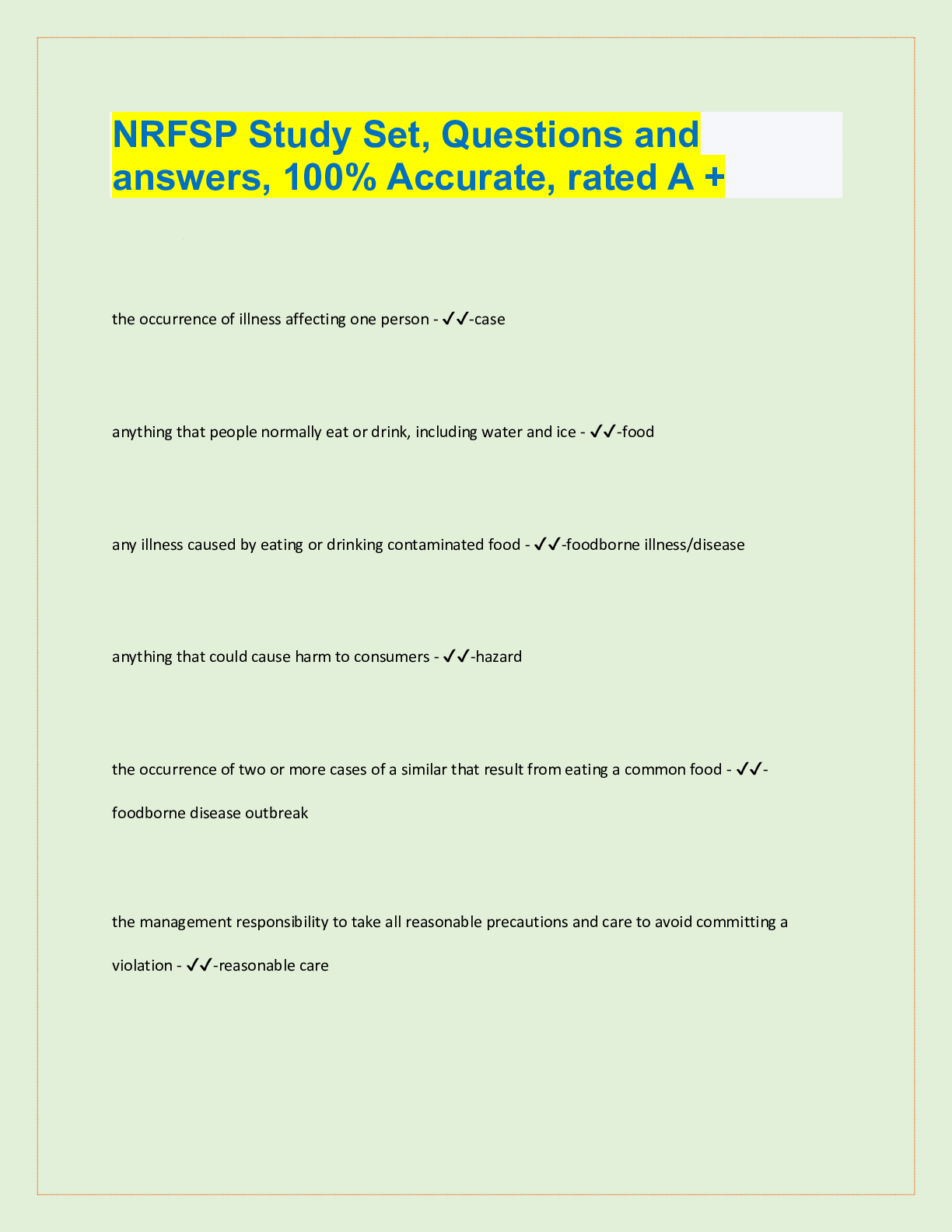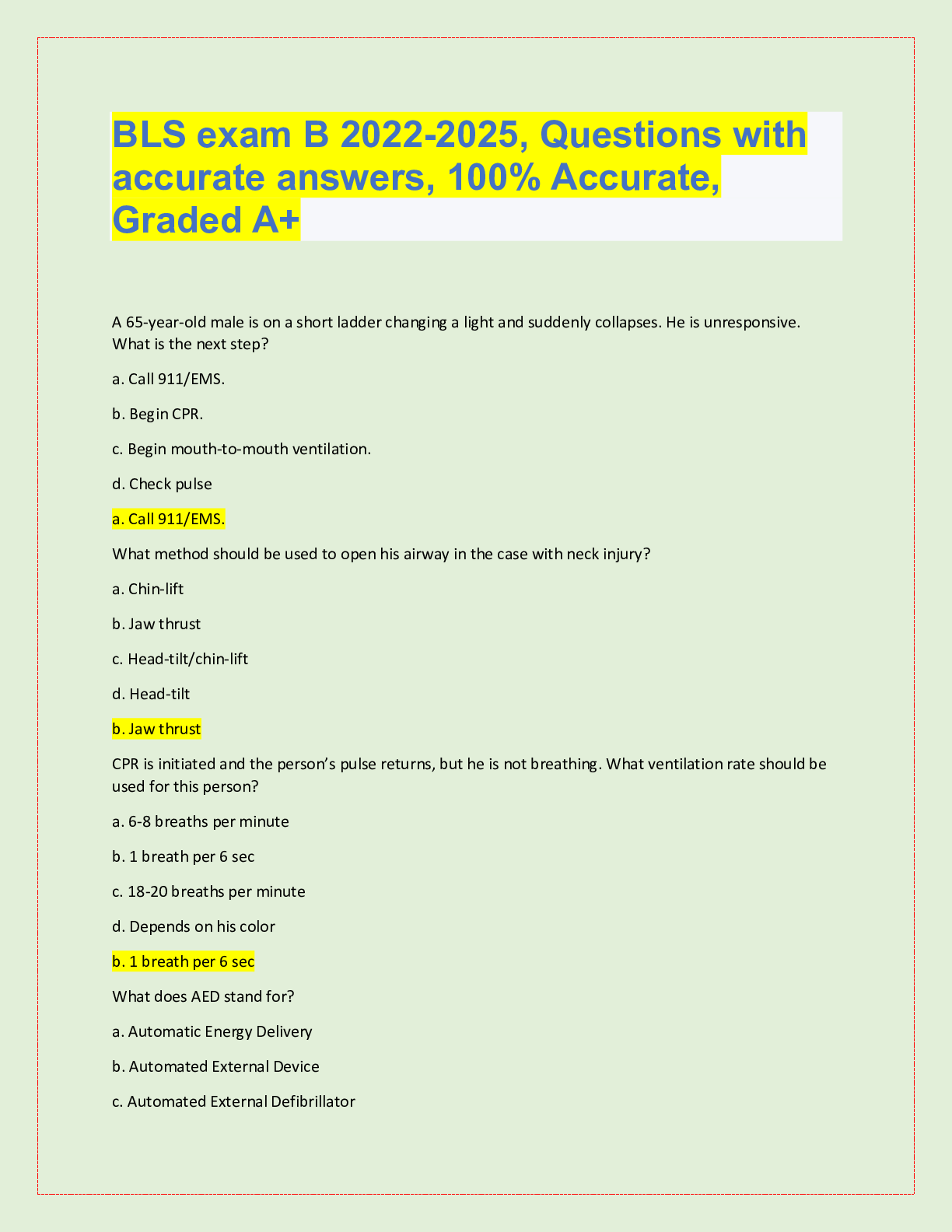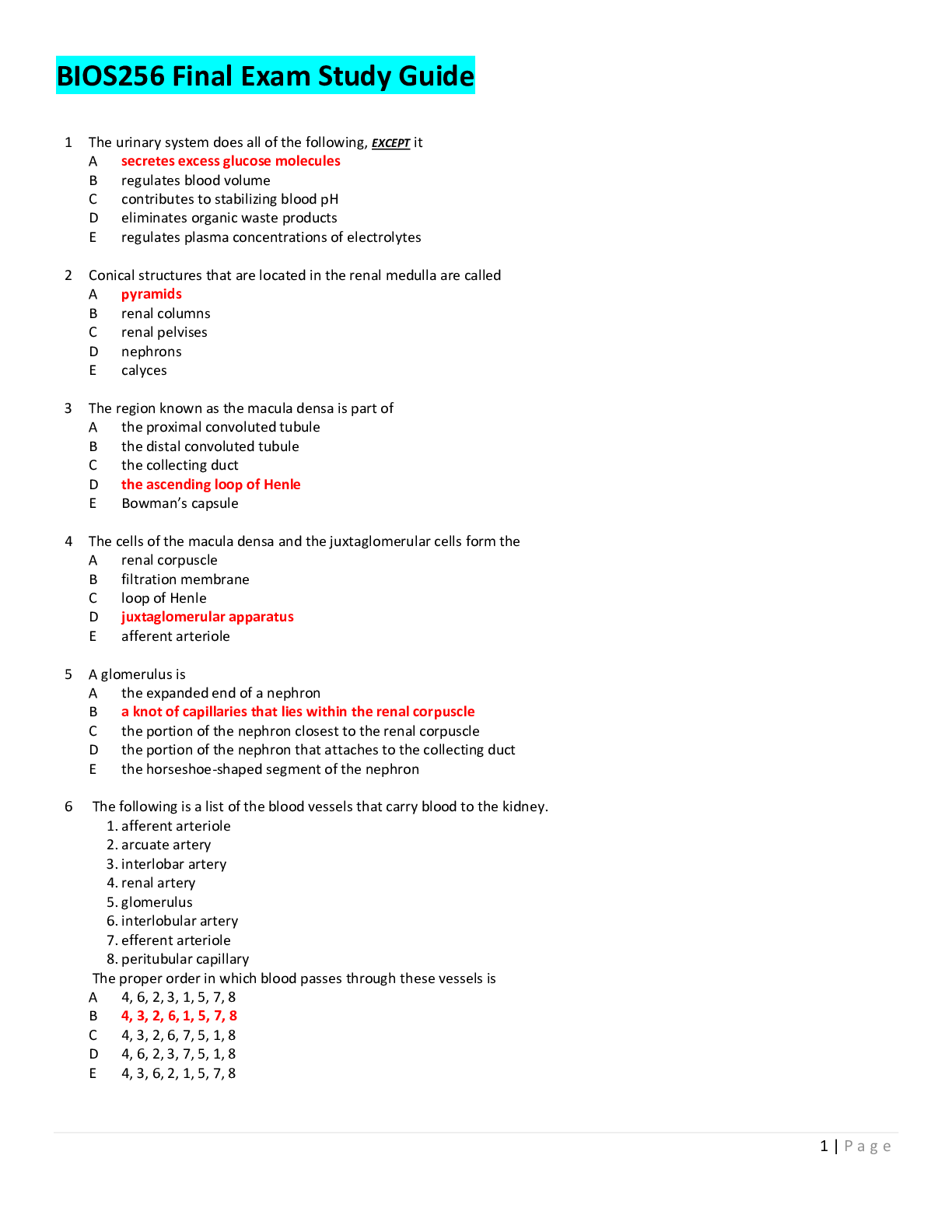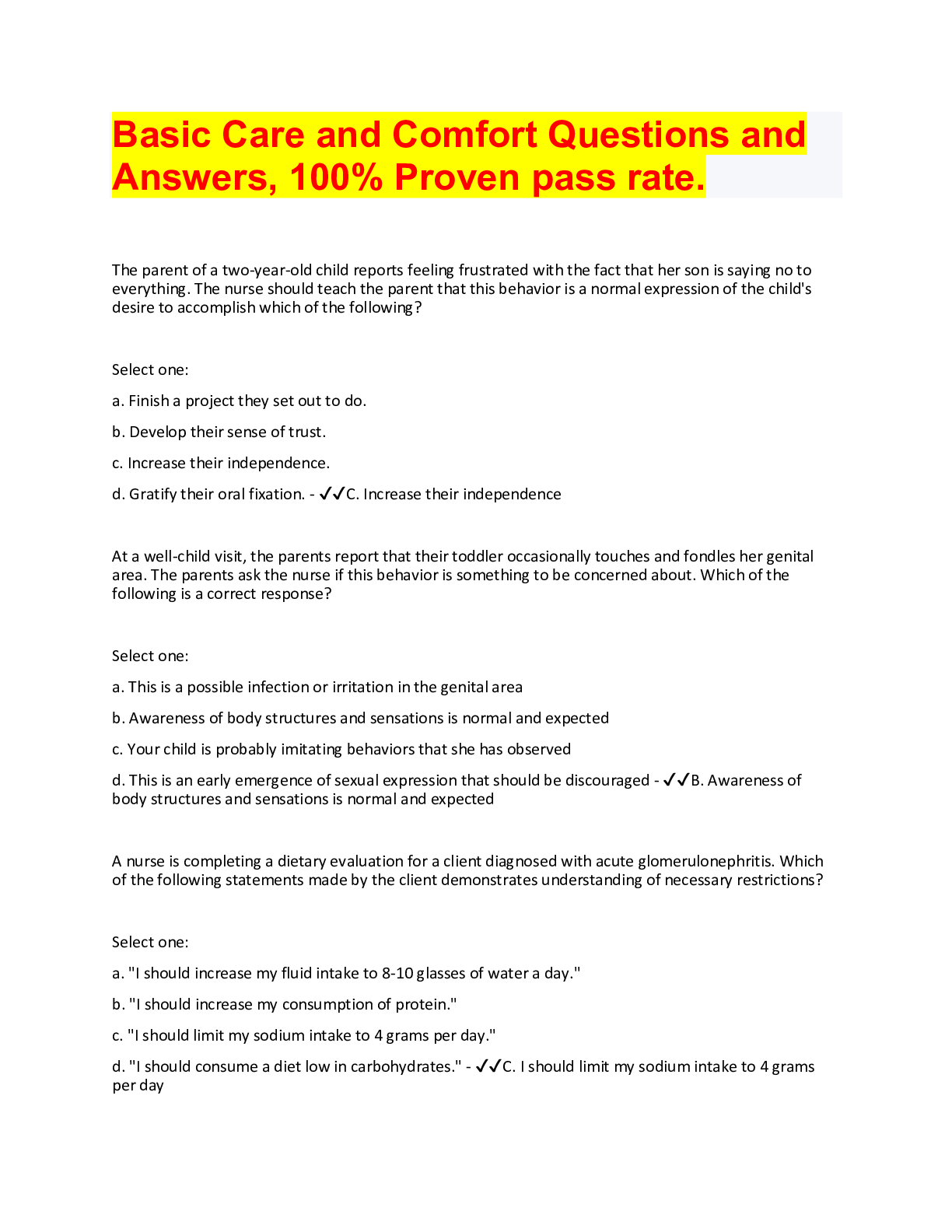Food and Nutrition > QUESTIONS & ANSWERS > NRFSP Study Set, Questions and answers, 100% Accurate, rated A + (All)
NRFSP Study Set, Questions and answers, 100% Accurate, rated A +
Document Content and Description Below
NRFSP Study Set, Questions and answers, 100% Accurate, rated A + the occurrence of illness affecting one person - ✔✔-case anything that people normally eat or drink, including water and ice - ... ✔✔-food any illness caused by eating or drinking contaminated food - ✔✔-foodborne illness/disease anything that could cause harm to consumers - ✔✔-hazard the occurrence of two or more cases of a similar that result from eating a common food - ✔✔- foodborne disease outbreak the management responsibility to take all reasonable precautions and care to avoid committing a violation - ✔✔-reasonable care Included in the duties of the person-in-charge are ensuring that the relevant regulations are observed and the employees: - ✔✔-1. Clean their hands effectively 2. Cook/cool time/temperature control for safety foods properly 3. Receive proper training in food safety that is relevant to their assigned duties particular types of poison produced by some molds Food sources: cereals, grains, nuts, dried fruits Symptoms: cramps, severe bleeding, swelling, weight loss, liver damage Onset time: wide variation - ✔✔-mycotoxins bacteria, viruses, parasites (tapeworms, roundworms & protozoa), fungi (mold & yeasts), naturally occurring poisons (often in fish & mushrooms) and mycotoxins - ✔✔-Biological foodborne hazards cleaning/sanitizing products, machine oil, pesticides, food additives, dissolved metals from the inappropriate use of metal containers - ✔✔-Chemical foodborne hazards broken glass,packaging materials (string, paper & staples), leaves, stalks, scales, feathers, shell/bone, nuts/bolts/screws, jewelry, hair, nails, nail polish, bandages, dust/dirt, bodies/eggs/droppings of pests - ✔✔-Physical foodborne hazards microorganisms responsible for may foodborne illnesses. The pathogenic kind are responsible for the most foodborne illnesses that result in hospitalization and death - ✔✔-Bacteria the presence in food of any harmful or objectionable substance or object - ✔✔-contamination a substance in food that causes an allergic reaction with symptoms ranging from mild to life threatening - ✔✔-food allergen life-threatening response that includes closing of the throat and wheezing caused from eating a protein of a food - ✔✔-anaphylaxis (anaphylactic reaction) any surface that is touched by food - ✔✔-food-contact surface an surface that is touched by hand - ✔✔-hand-contact surface a very small life form including bacteria, viruses, molds, yeasts, and some parasites - ✔✔-microorganism (or microbe) safe for humans to drink - ✔✔-potable an organism that causes disease - ✔✔-pathogen the process by which food becomes unwholesome - ✔✔-spoilage hands, utensils or tools that can carry microorganisms onto food, causing contamination - ✔✔-vehicles of contamination an organism that lives on or in another life form - ✔✔-parasite a poison produced by some living organisms, such as bacteria, molds, and algae - ✔✔-toxin an extremely small, highly infectious pathogen - ✔✔-virus food sources: amberjack, barracuda, grouper, mackerel, and snapper symptoms: dizziness, reversal of hot/cold sensations, diarrhea, vomiting - ✔✔-ciguatera toxin also known as histamine poisoning Food sources: fish like tuna, bonito, mackrel, or mahi mahi Symptoms: burning in the mouth, dizziness, hives, pepper or metallic taste in mouth, itchy eyes Onset time: 1-30 minutes - ✔✔-scromboid poisoning paralytic shellfish poisoning caused by fish - ✔✔-PSP diarrhetic shellfish poisoning - ✔✔-DSP neurotoxic shellfish poisoning - ✔✔-NSP amnesic shellfish poisoning - ✔✔-ASP parasite like Trichinella spiralis and Anisakis - ✔✔-roundworms parasite found in beef, pork and fish - ✔✔-flatworms single-celled microorganism parasite like Giardia lamblia and Cryptosporidium parvum - ✔✔-protozoa parasite/roundworm found in hogs - ✔✔-Trichinella spiralis parasite/roundworm found in fish such as cod and herring - ✔✔-Anisakis an illness caused by pathogenic microorganisms that live and multiply in your body after you have eaten contaminated food - ✔✔-foodborne infection an illness caused by toxins in food - ✔✔-foodborne intoxication the time it takes for the symptoms of a foodborne illness to start after contaminated food has been eaten - ✔✔-onset (or incubation period) an illness caused by eating live pathogens that make toxins as they live in the stomach or intestines - ✔✔-toxin-mediated infection elderly pregnant women and unborn babies breast-fed babies and the very young people who are ill, recovering from illness or who have weakened immune systems (immunocompromised) - ✔✔-highly susceptible populations caused by Camplyobacter jejuni, Listeria, Salmonella, Shigella, and Vibrio - ✔✔-bacterial infections caused by Bacillus cereus, Clostridium botulinum, and Staphyl [Show More]
Last updated: 2 years ago
Preview 1 out of 18 pages

Buy this document to get the full access instantly
Instant Download Access after purchase
Buy NowInstant download
We Accept:

Reviews( 0 )
$8.00
Can't find what you want? Try our AI powered Search
Document information
Connected school, study & course
About the document
Uploaded On
Mar 17, 2023
Number of pages
18
Written in
Additional information
This document has been written for:
Uploaded
Mar 17, 2023
Downloads
0
Views
64

















, Question Answers, 100% Correct , Correct Answers.png)

.png)
, Question Answers, Correct , Correct Answers.png)





